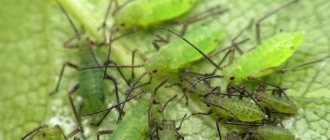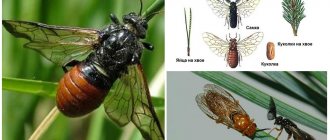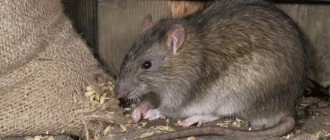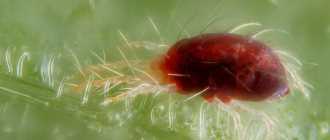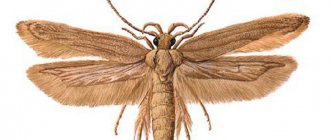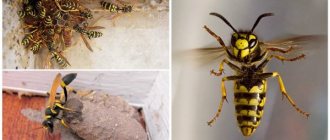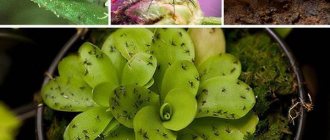We determine the damage to plantings by this pest
Several varieties of such insect pests have become widespread, often settling on shrubs and fruit trees.
Aphids may differ in size and appearance, but all their varieties exhibit the same behavior. Insect colonies are localized on the back side of young leaves and at the base of annual shoots on cherry trees. Aphids do not tolerate the sun well, so they try to stay in the shade, under young leaves. This insect feeds on plant sap, and the easiest way to get such food is from young leaves and stems of cherries.
If this pest multiplies uncontrollably on a cherry tree, the affected foliage quickly curls, does not participate in photosynthesis, and soon withers. Cherry berries also soon fall from the trees.
Black cherry aphids are most often observed on cherries and other stone fruit crops. These insects multiply quickly, so the gardener needs to take appropriate measures at the first signs of the appearance of such pests in the garden.
In just a matter of days, all young foliage, berries and shoots can be strewn with black microscopic swarming dots. Determining the presence of such pests on cherry trees is not difficult. It is necessary to inspect the foliage for the presence of small black insects that live in colonies on the back of the foliage.
An indirect sign of the presence of this pest on a cherry tree is a large number of ants constantly scurrying along the branches. Ants on cherries feed on the milk of aphids and are even able to reproduce and maintain their colonies of such insects in a viable state. That is why this problem should be dealt with comprehensively, destroying both the ants and the aphids themselves.
Agrotechnical methods - as an alternative to chemistry
Treating trees against aphids is only one stage of the fight. In this case, it is much more important to ensure that the effect of the selected methods is prolonged. Agrotechnical measures to destroy this dangerous parasite are aimed at solving this problem. These include weed control. Another precaution is to carefully dig up the soil in the fall and spring. This will detect and destroy pest eggs.
Changing the location of plantings is an important element of protecting a site from them. Tomatoes, potatoes, and melons should be replanted more often. It is also worth planting plants that are natural enemies of aphids in potato beds.
Another measure of agricultural management is pruning and disposal of leaves and branches. Affected shoots must be sawed off or cut and burned. Exposure to fire will leave no chance of survival for larvae and adults. In addition, you should carefully monitor the appearance of ants in the area. They carry insects during grazing and help expand their habitat. Accordingly, all participants in this symbiosis will have to be destroyed.
Morphologically related species
In terms of external characteristics (morphology), Myzus formosanus and Myzus dycei are close to the described species:
- Wingless individuals of Myzus formosanus. The tubes are no longer than the tail and are not curved towards the apex. The abdominal tergites are not sclerotized, sometimes with brown, unevenly distributed spots. The color of the integument is light brown and brownish-red. They develop on knotweed.
- Flightless individuals of Myzus dycei. The tubes are 3–3.5 times longer than the tail, curved outward at the apex. The abdominal tergites are sclerotized, wrinkled, and not covered with spots. The color of the integument is light or yellow-green. They develop on nettles.
The appearance of aphids: causes and prevention
During evolution, aphids have adapted to changes in plant life and climate change. Colonies can be different in species composition and flexible to external stress. Aphids are dioecious insects. To complete the seasonal reproduction cycle, it requires the presence of a nearby weed plant - bedstraw. Clean the area around the tree and the garden in general from parasitic plants.
There are other preventative methods:
- Regularly wash off or otherwise mechanically remove sticky honeydew from the leaves. Firstly, it is a bait for ants, and secondly, it is a breeding ground for sooty fungus.
- Keep ants away from the tree.
For this purpose, hunting belts and sticky traps on the trunk, sprinkling ant clutches with eggs with boiling water, and destroying anthills on the site are suitable. Also fight ants - Free the tree from old, peeling bark, whitewash the trunks in the fall or spring, before the buds swell.
- Remove young growth from the roots of the tree. Its soft and juicy tissue is an ideal habitat for aphids.
- Help strengthen leaves. A tight leaf is more difficult to bite through, which means it will be less attractive to the pest. This is achieved by sprinkling the crown, regular watering, mulching, and balanced nutrition. But you can’t overdo it with nitrogen fertilizing.
- Plant garlic, onions, Dalmatian chamomile, and marigolds near the cherries - aphids do not like their smell. Conversely, place hollyhocks, cosmos and nasturtiums that attract this insect away.
- Calendula will also have a beneficial effect on the health of the fruit tree next to it - it attracts ladybugs, which are enemies No. 1 for aphids. You can also increase the population of ladybugs in the garden mechanically - ask the children to collect them from the surrounding area.
Attention! Among garden crops, aphids love cherries and viburnum the most, so the farther they are from other fruit trees, the better.
Life cycle
Reproduction and development of the pest begins in the spring . Larvae from eggs laid by females in autumn . They immediately begin to suck the juice of young host plants.
After molting, the larvae develop into fertile wingless females . These individuals no longer lay eggs and give birth to live larvae . Moreover, they do not need males for summer reproduction.
These larvae are ready to reproduce after 1–2 weeks. In a month, each of them is capable of producing several generations, numbering up to hundreds of thousands of individuals . In the second generation winged females are born , capable of migrating long distances, colonizing and reproducing on new plants of the same species or on closely related crops. In just one summer, up to 17 generations of winged and wingless females can appear .
The autumn colony is already heterosexual; not only winged females appear in it, but also males. They fertilize females so that they lay shiny eggs for wintering on perennial plants: weeds, shoots, tree shoots, and anthills. The next year the breeding cycle repeats again.
The importance of aphids in biogeocenosis and nature
Aphids are carriers of plant viruses and parasites. It also regulates the process of photosynthesis - while sucking juice from young plants, aphids remove excess sugar, which is excreted in the form of sweet drops and enters the ground, saturating it with nitrogen. In addition, aphids are useful to ants, which collect sweet drops and feed them to the queen and offspring. Due to the beneficial consumption of dew, ants can protect aphids from attack by dangerous insects such as ladybugs.
Why are aphids classified as homoptera? The insect has a proboscis, which plays the role of an oral apparatus. Despite the lack of wings, aphids have complex developmental stages in which the wingless form of the insect acquires wings of equal shape and size.
Appearance - close-up photo
The insect's appearance and body shape differs by appearance. The body can be ovoid, oblong or elliptical. Sizes vary from 0.3 mm to 0.8 mm. Some species of aphids are larger than a millimeter in size, but this is found in the founders of colonies. The integument is usually transparent, and the color is determined by the composition of the hemolymph, the thickness of the skin and the presence of a waxy coating.
The color of the abdomen can be very diverse - green, gray, black, red, brown, beige. Basically, the color is similar to the plant that the insect feeds on. On the surface of the body there are tubercles and fluff; in some species the fluff can reach 4 mm in length.
The insect has six legs, three on each side. The larvae are a smaller form of the adult, with the proboscis usually longer in relation to the body. The tail is not fully developed. Females are larger in size than males.
Habitats
Insects love warm and humid climates, which promote reproduction and development. The habitat covers Western Europe and Siberia. Eggs cannot withstand cold temperatures of more than -25 degrees. Reproduction is prevented by temperature changes, rainfall or drought. Aphids are found in the above-ground parts of plants or underground if the insect sticks to the roots. It can be found in greenhouses and on grass.
IMPORTANT: it is worth periodically inspecting the plants in order to notice the pest in time.
How to fight with biological substances?
You can protect cherries from pests in other ways that are safer for people. So, there are plants that attract or, conversely, repel aphids. Both can be used to protect cherries.
The first ones should be planted away from the garden, thus distracting aphids from trees with berries. This group includes:
- petunia;
- mallow;
- cleome;
- poppy;
- bird cherry;
- viburnum.
But plants from the second category repel pests with their phytoncides. Therefore, they can be planted next to cherries. Onions and green garlic, marigolds, lavender, fennel and mint have such properties.
It is also worth remembering that in nature aphids have their own enemies: ladybugs, predatory bugs, ground beetles and other insects. Many gardeners prefer to attract them to their plot. This can be done by planting daisies, nightshade family plants and ferns in flower beds.
Agrotechnical methods of control
Experienced gardeners use all available means to combat aphids. So, many of them resort to the help of natural enemies of these pests or plant the necessary flowers and herbs next to the cucumbers.
Attracting insects
Other insects can help gardeners deal with aphids.
These pests are most afraid of ladybugs. And not in vain, because this insect is quite voracious. In just one day, a ladybug can destroy about 200 adult aphids. The eggs of these insects for the greenhouse can be purchased at a garden store. In greenhouse conditions they will develop very quickly.
Hoverflies. These flies are also excellent helpers in the fight against aphids. Thus, one hoverfly larva can eat up to 500 individuals during this stage.
Lacewings. They can deal with an entire colony of aphids in a short time
To attract their attention, just hang clay pots filled with wood shavings or straw in the greenhouse.
Planting bait from plants
You can also plant plants between the cucumbers that aphids love more than cucumbers. You can use dill, sow thistle, and various types of legumes. When a large number of pests accumulate on these plants, they must be pulled out of the ground, immediately removed from the site and destroyed.
Planting repellent plants
Many garden plants, as well as aromatic herbs, are simply not tolerated by aphids. These include the beloved mint, fragrant marigolds, healthy cilantro, basil, and mustard. It is best to plant plants along the entire perimeter of the greenhouse or greenhouse, as well as between the rows.
Signs of defeat
It is very easy to identify black aphids by their external characteristics. This is a small insect whose body is no more than 7 mm. The favorite habitats of black aphids are the undersides of juicy leaves of cherries, sweet cherries and other berry bushes. The pest prefers to attack trees that are protected from sunlight and rain.
Black aphids gather in large colonies that “stick” to the leaves, ovaries, branches and trunks of fruit trees.
Signs of damage:
- there is a cluster of small black insects on the underside of the leaves;
- the affected leaves curl, fade, wither and fall off;
- If you touch the surface of the affected leaf with your hands, a sticky substance will remain on your fingers.
Black aphids are a dangerous pest for cherries. If you do not start fighting insects in a timely manner, the tree will stop growing, will lag behind in development, will weaken, it will be difficult for it to survive winter frosts, and it will become sensitive to bacterial, viral and fungal infections.
Protecting cherries from the leaf roller pest
Enarmonia for-mosana Scop. (syn. Laspeyresia woeberiana Schiff., L. ornatana Hb.) - a butterfly with a wingspan of 14-16 mm, flies at dusk and at night. The front wings are very bright, with a golden-brown pattern, the hind wings are dark brown, with yellow-golden fringe. The caterpillars are dirty white in color and feed under the bark of trees, gnawing through vertical passages and polluting them with excrement.
In places of damage, rusty-red plugs of excrement stuck together with cobwebs protrude from holes in the bark. The caterpillars overwinter under the bark, feed additionally in May and pupate there. To protect cherries from this pest, it is necessary to install traps. During the flight of the butterfly, the shell of the pupa moves halfway out of the bark. Butterflies lay eggs at the base of skeletal branches, near cracks and mechanical damage, but more often in the lower part of the trunk of young trees at the root collar at soil level.
The newly born caterpillars bite into the bark and feed under it. In places of damage, gum often appears, and sagging and growths form. If the pest population is large, young trees dry out within 2-3 years. The leaf roller damages stone fruit and pome crops, but most severely - cherries, sweet cherries and apricots.
Control measures. To protect cherries from pests, the trunks and trunks are sprayed at the end of May - beginning of June, during the summer of butterflies, with the drug fufanon or its analogues (kemifos, karbofos). Cleaning the trunks from the upper dead layer of bark, whitening the trunks and root collars with a suspension of chalk with the addition of any organophosphorus preparation. If the pest population is large, you can inject the drug Actellik without diluting it with water - inject drops from a syringe into the holes in the bark (2 ml/m2).
Bud roller.
The bud roller, or bud roller Spilonota ocellana F. (syn. Tmetocera ocellana F.), is a butterfly with a wingspan of 14-18 mm. The front wings are gray with a wide white stripe in the middle and several dark strokes, the hind wings are brownish-gray. The eggs are transparent, shiny, the caterpillar is 9-12 mm long, brown, with a black head and a black chest shield. The pupa is brown, 6-8 mm long. Third instar caterpillars overwinter in white cocoons near the buds and in cracks in the bark. In early spring they emerge from the cocoon, bite into the buds and feed on the rudiments of leaves. After the buds open, the caterpillars feed on the buds and leaves, pulling them together into a dense lump with a web.
Having finished feeding, the caterpillars pupate and about 9-15 days after the end of flowering of the apple trees, butterflies fly out. The flight of butterflies is extended, and the mass flight is observed from the second ten days of June. Each female lays up to 180 eggs, placing them one at a time on the upper side of the leaves. The hatched caterpillars live between two leaf blades held together by a web, or between a leaf and a fruit to which it is attached by a web. The caterpillars are yellow-green, with a black head and chest shield.
From a young age, they gnaw out leaf parenchyma and fruit skin, which leads to deformation and drying out of damaged leaves and fruits. The leaf roller damages all fruit and many berry crops, as well as forest species.
Control measures. If there is a large number of pests in the garden, annual spraying is carried out in early spring, during the swelling of the buds, with one of the drugs: Fufanon, Kemifos, Actellik. The treatment is repeated 2-3 weeks after the end of flowering of the apple trees.
Description of black aphids
Aphids are insects from the genus Hemiptera. Cherries, plums and other stone fruits are attacked by black aphids. These are small creatures that reach a size of no more than a couple of millimeters. The body shape of an insect is always different.
Aphids can be both wingless and winged. The wingless type of insect does not leave its habitat and constantly reproduces there. One individual insect can produce 4-5 generations of offspring within a couple of months. The number of individuals reaches several hundred thousand, which constantly reproduce. In summer, 10-12 generations can be born.
Aphids are attracted to cherries by their juice. They extract it from the plant by piercing the surface of the shoots with their proboscis. Aphids prefer the juiciest plants for food; it is easier to get food from them. Black aphids infect the bases of leaves and tops of shoots.
The winged subspecies spreads aphids to other plants. It is not born in every generation, but only when the colony becomes too large for one plant. Also, winged aphids appear during cold weather and other unfavorable conditions.
During feeding, aphids secrete sweet honeydew, which attracts other garden insects. Bees use honeydew to create honeydew honey. The main lovers of the sweet substance are ants. They become a kind of protectors of aphids. Ants protect aphids from other insects and transfer them to other plants.
Damage from black aphids on cherries
The action of the pest leads to the following negative consequences:
• infestation by aphids can lead to the death of the tree; • plants have an increased chance of being infected by various viruses; • yields are significantly reduced; • berries become small and ugly; • the possibility of infection of all neighboring plants.
Black aphids can infect currants, gooseberries, raspberries and other neighboring plants. The insect can also harm plums, apricots and other stone fruits. The pest feeds on plant sap, which disrupts the flow of nutrients into the leaves. They dry out and curl, and the affected surface turns black.
There is a risk of getting infected from black aphids. Various fungal diseases can develop on the shoots. Along with insect saliva, various microorganisms enter the cells. Sooty fungus can lead to crop loss, and if the tree is not cured before winter, it will die.
Disadvantages of chemistry
The disadvantage of this product is its wide spectrum of action. Not only black aphids die on cucumbers and tomatoes, but also beneficial insects. Bees that pollinate plants, ladybugs are natural enemies of aphids and other living creatures.
If the concentration and frequency of processing are violated, toxic substances accumulate in the fruits. The last treatment with an insecticidal agent should be carried out no later than 20 days before the start of harvest.
Folk remedies for aphids
To protect plants from gall aphids, you can use not only chemicals. Folk remedies are also suitable for exterminating insects.
Spraying against aphids
Over the years, gardeners have discovered many recipes to help kill aphids. For example, after routinely washing off parasites from the leaves, you can spray them with a soap solution. Laundry soap is grated and diluted with water in the proportion of 300 grams of soap per bucket of water. Regular soap can be replaced with liquid soap; you can add half as much of it. You will need about 100 grams of tar soap per 10 liters.
Herbal infusions
Just because herbal infusions are not chemicals does not mean that they can be used in any quantity. Strong concentrates can not only cause burns, but even destroy the plant. Some infusions can pose a danger not only to aphids, but also to other insects, and especially poisonous ones have a bad effect on the human body.
In order to use the solution throughout the entire area, you need to test it on one or two plants. If the result meets expectations, then you can spray the entire area.
Onion from aphids
One of the best herbal infusions against aphids can be called onion. 35-40 grams of chopped onions are poured with a liter of water and the infusion is kept for about five hours. Then add 5-6 grams of laundry soap, and then filter and treat the plants.
Garlic from aphids
Garlic infusion is made from 250 grams of heads in one liter of water. Leave for up to 5 days, use 30 grams per 10 liters of water.
Tobacco against aphids
For tobacco infusion, 250 grams of tobacco leaves are poured with 5 liters of water for several days. After this, dilute with water to 10 liters and treat the plants.
There are many folk recipes against aphids - marigold, chamomile, pine, pepper, citrus, sorrel.
Fumigation with smoke from aphids
The fumigation method is usually used in indoor greenhouses, but it is quite possible to use it to get rid of aphids outdoors.
So, the method is that in any metal container you must first make a small fire from thin twigs, and then pour tobacco into it. It can be taken from cheap cigarettes or cigarettes. The smoke that comes out of the dishes can destroy not only aphids, but also many other parasites on plants.
Using chemicals
Many chemicals have been created that can destroy black aphids.
In case of massive damage to plantings, try using the following chemicals:
- “Fitoverm” is a fairly effective drug, the active ingredient of which is aversectin. The substance affects the nervous system of black individuals, thereby killing them.
- "Entobacterin" - this product also copes well with colonies of parasites on cucumbers. After spraying the garden, the aphid gets sick and dies after 6–7 days.
- "Metaphos" - the advantage of this drug is the long-lasting effect after its use. Treatment of bushes should be carried out in calm weather.
- "Inta-vir" - the active ingredient here is cypermethrin. Its concentration is 4%. The product causes paralysis in aphids and then rapid death. You can purchase the product in the form of tablets or powder, which must be diluted with water. Spraying this product increases the overall resistance of cucumber bushes to various pests, including aphids.
- “Spark” - in addition to the active toxic substance, this product contains potassium additives and anti-stress components that help the crop quickly overcome “shock”. The drug protects the plant from repeated attacks by the pest. Each subsequent spraying is carried out 15 days later until the aphids completely disappear.
- "Karbofos" is a toxic product that can save cucumbers when they are severely infested with black aphids. The use of the chemical gives immediate results. The drug has a contact effect, exterminating mature individuals and larvae.
- “Arrow” - the active component in this case is bitoxybacillin. This is a gray powder containing bacterial spores that cause significant damage to parasites. It is possible to completely clear a plot of land in 10 days.
- “Aktara”, “Tanrek” are similar means of systemic action. You will have to wait about 7 days for the result, but the effect fully lives up to expectations.
Aphids appear on cucumbers in a greenhouse much earlier than in the open air. Greenhouse conditions are more favorable for it - the pest is warm and dry. Control measures are the same as on open ground.
Before using these drugs, all ripe cucumbers must be removed from the bushes. When working with chemicals, strictly follow safety precautions: protect exposed areas of the body, do not forget to wear a respirator and special glasses.
Causes of the pest
Black aphids can appear in a cherry orchard in early spring, summer, and late autumn. A winged insect can simply fly to a tree, after which a whole colony of pests will settle on it.
If there are anthills with forest ants in the garden or nearby, this increases the likelihood of trees being infected with black aphids. Forest ants are “guards” and carriers of insects, so by getting rid of them, it will be possible to protect the garden from attacks by aphids.
The germination of weeds near the garden - bedstraw - also causes the spread of aphids. Clearing the garden surroundings of weeds will be a preventive measure against black aphids.
https://youtube.com/watch?v=FqSQ84Vj1U8
Folk remedies for aphids on cherries
There is a category of people who, fearing the negative effects of chemicals, are wary of using them in pest control. Then they are faced with the question: if there are aphids on the cherry, how to get rid of them using folk remedies? Such drugs are characterized by the following features:
- have a repellent effect - very often these are infusions of appropriate herbs;
- are considered environmentally friendly products;
- prepared from widely used and commonly used household products;
- They act for a short period of time and require frequent re-application.
It is necessary to mention how to get rid of aphids on cherries, eliminating the penetration of insects into the crown of the tree. We are talking about sticky and other traps installed on the trunk. Several varieties are used:
- a funnel belt directed with a “bell” downwards;
- double-sided funnel;
- collar belt (“cup” with oil around the barrel);
- poisonous trap (the belt is saturated with poison);
- sticky belt (lubricated with resin, glue or tar).
Soap for aphids on cherries
It is recommended to add ash to the solution before spraying to enhance the effect. A soap solution for aphids is made as follows:
- Grate a piece of laundry soap (72%) on a coarse grater.
- Heat a small amount of water.
- Dissolve grated soap in hot water.
- Dilute the cooled concentrated solution with 10 liters of water and stir well.
- Moisten the tree and spray the leaves on both sides. You can also use tar soap.
https://youtube.com/watch?v=Y8AimDB75iA%250D
Garlic from aphids on cherries
This plant is often used for pest control. They cannot tolerate the pungent odor produced by phytoncides. A garlic solution for aphids is prepared either from green garlic shoots or cloves at the rate of 200 g of plant per liter of water. It is recommended to alternate with spraying with celandine infusion. Preparation procedure:
- Grate the garlic or chop it in another way.
- Dilute with water and leave for 5 days.
- Strain and store the concentrated solution in a dark place.
- Before spraying, dilute 50 ml of concentrate with a bucket of water.
Coca-Cola for aphids on cherries
The most exotic drug against the parasite. Coca-Cola against aphids can help because this drink contains phosphoric acid. This component kills harmful insects. The sweet liquid glues the aphid to the leaf or significantly immobilizes it. To prepare the solution, Coca-Cola must be diluted with water in a 1:1 percentage ratio and sprayed on both sides of the leaves.
Soda for aphids on cherries
This is the easiest way to get rid of insects. A soda solution for aphids can be prepared by dissolving 100 g of baking soda in a volume of 10 liters of water. Sodium bicarbonate, with its alkaline environment, kills cherry aphids. On the contrary, soda has a positive effect on wood. It promotes foliage growth. Thus, using baking soda you can achieve a double effect.
Celandine against aphids on cherries
Often this plant is perceived as a weed, and it is weeded and thrown into humus. However, celandine is a very useful plant. It is not only used in folk medicine, but also perfectly fights aphids. When preparing the product, it is necessary to observe safety precautions, since the juice of the plant is poisonous. A solution of celandine against aphids is made as follows:
- A large bunch of the plant (about 10 cm in diameter) is cut into pieces.
- Soak 5 liters of water. The soaking process should last at least 3 hours. It is recommended to intensively mash the plant stems to release more juice into the water.
- Add about 1 tbsp to the bucket. spoons of liquid soap. It allows the solution to better adhere to the foliage and prevents premature evaporation.
- When the water turns yellowish, you need to strain the solution.
- The finished product is poured into a sprayer and the trees are generously treated.
How to deal with aphids in the garden
Naturally, it is impossible to leave everything as is, so as not to lose a significant part of the future harvest. The fight against aphids should be started as soon as it is discovered. You can save a tree using folk remedies, agrochemicals, or attracting natural enemies of the pest. Each of these methods has its own advantages and disadvantages. Which one would be more appropriate to use depends on the desires and capabilities of the gardener.
Folk remedies
If there are still few aphids, it is better to try to get rid of them using water, that is, simply wash them off with a stream of water. But this method is only suitable if the pests have not yet had time to multiply significantly.
In addition, you can fight with folk remedies. They are not as aggressive as industrially produced insecticides, and are not harmful to plants or poison them. But it should be borne in mind that folk remedies are not so effective - you will have to process cherries not just once per season, but several times.
Soap and ash
Recipes for killing cherry aphids:
- Soap solution. You will need to dissolve shavings from ½ piece of laundry soap (150 ml liquid or 150 g tar) in 10 liters of hot water. Spray the cherries with this solution.
- Infusion of ash. This product is doubly useful: it not only destroys aphids, but also feeds the cherries with mineral elements. It’s easy to prepare: pour 0.3–0.5 kg of ash into 5 liters of boiling water and leave to steep in a sealed container for a day. Then add another 5 liters of water, add 50 g of any soap and use the infusion for spraying.
According to gardeners, these aphid repellents are time-tested and show good results after the first use.
Plant infusions
No less effective in the fight against aphids are plants with insecticidal properties, which can be found in any farm.
Top 10 herbal infusions against aphids:
- Onion. Take 30 g of husk, pour 1 liter of boiling water, leave for 6 hours. Add a little laundry soap to the liquid to make the product stick to the leaves.
- Garlic. Leave 200 g of crushed cloves in 1 liter of water in a sealed container for 5 days. Before use, dilute 25 g of infusion in a bucket of water.
- Tobacco. Infuse 200 g of dry leaves in 5 liters of water for 2 days. Add another 5 liters of water.
- Chamomile. Leave 100 g of inflorescences and herbs in 1 liter of water for 12 hours. Working solution: dilute the infusion with water 1 to 3, add 5 g of soap for every 1 liter of the resulting liquid.
- Marigold. Fill the bucket halfway with crushed plants (along with flowers), add water to the top, leave for 2 days, and add 50 g of soap to the bucket before spraying.
- Hot pepper. Infuse 1 kg of fresh pepper in pods or 0.3 kg of dry pepper in 10 liters for 24 hours. Dilute with water 1 to 10.
- Pine. Infuse 1 kg of pine needles in 4 liters of water for a week. The concentration of the working solution is 1:1.
- Citrus. Pour 100 g of dry crusts into 1 liter of hot water and leave for 3 days.
- Potatoes or tomatoes. Leave 1 kg of fresh or 0.5 kg of dry tops in a bucket of water for 6 hours.
- Celandine. 400 g of fresh herb or 100 g of dry herb, pour 1 liter of boiling water, leave for 1–1.5 days.
You need to spray thoroughly so that the solution gets on both surfaces of the leaves and shoots. Cherries can be processed during budding, after flowering, during the period before the berries ripen, but no later than 2 weeks before they are collected.
Agrochemistry
Those who want to deal with black aphids “immediately and forever” will, of course, have to choose synthetic insecticides. They act quickly and most effectively, but you need to remember that they can only be used at the beginning of the season, and not when the berries are already ripe.
Insecticides you can use in your home garden include:
- "Spark";
- "Fitoverm";
- "Commander";
- "Aktara";
- "Corado";
- "Confidor";
- "Fufanon" and others.
It is recommended to spray cherries for prevention even before the buds open - this will destroy overwintered aphids. And during the season it is better to alternate drugs so that the pest cannot get used to one of them.
The last treatment before picking berries must be carried out no later than the time specified in the instructions for the drug as the waiting period!
Herbal infusions and decoctions
There must be a “garden pharmacy” on every site or beyond. These are plants that repel aphids and other pests. Gardeners have long known recipes for infusions and decoctions from available wild and garden crops.
Tobacco
The infusion is prepared in this ratio
- 40 g of crushed fresh leaves for every liter of water.
Pour water over the tobacco and leave for two days. Before use, strain the infusion and add water 1:2.
According to another recipe, an infusion can be prepared from dry tobacco dust. You will need half a glass. The powder is poured into a liter of water and boiled for 0.5 hours. The broth is infused for two days in a dark place. After 2 days, you can filter it and add 2 liters of water. At this concentration it is ready for use.
Photo 4. Tobacco dust is a well-known insecticidal agent against aphids and other pests.
Elderberry
Our ancestors planted bushes near the house to repel annoying insects. Modern experts call this plant a natural insecticide. The specific smell of elderberry is not to the liking of ants and aphids. Even if it is not in your garden, you can find it in a forest or park and make an infusion from it:
- Pour 1 kg of young leaves (crushed) into 10 liters of water and leave for 12 hours. To process cherries, the infusion must be strained.
For infusion, you can use dry raw materials. It is prepared from inflorescences and dried in the shade.
To prepare the insecticide, you need 200 g of chamomile per 10 liters of water, leave for 12 hours.
The filtered cake can be filled again, but with a smaller volume of water - 5 liters.
Photo 5. Pyrethrum is sold in garden stores. It is produced in the form of a dry powder.
Prevention of damage to cherries by aphids.
In order not to fight aphids on cherries in the future, the necessary preventive measures should be taken.
There are quite a few simple methods, the basis of which is specific tree care:
- Every year in late autumn, after the leaves have fallen off or in early spring, it is necessary to treat tree trunks with lime mortar. This method of combating aphids repels insects and prevents the appearance of clutches of their eggs. Before processing the trunk, it must be cleaned of dry and damaged bark. Whitewash is applied to a dry and preferably at least slightly cleaned surface.
- Weeds around trees should be removed throughout the summer. This needs to be done because aphids often settle on herbaceous weeds, and, of course, then move to the cherries. If you do not start fighting pests in time, they will begin to move from trees to vegetable crops. Plants such as viburnum, hawthorn, linden and some others attract aphids with their scent, so you should avoid their proximity to cherries.
Thus, environmentally friendly tobacco dust has minor insecticidal properties and allows you to destroy tiny clusters of pests that are invisible to the eye of the summer resident.
It is best to use the described product during the flowering season on cherry and plum trees.
- Before removing aphids, fill the tobacco dust with water, using 1 kg of product per 10 liters of liquid.
- Boil the mixture for 30 minutes, adding water periodically.
- Then leave the decoction for at least 24 hours.
- The strained infusion is diluted with additional water.
Used for spraying trees for preventive purposes, when aphid accumulations are almost invisible.
You can improve the solution with the help of crushed laundry soap added to the mixture; it helps flush out pests.
If you don’t know how to get rid of black aphids forever, then think about a reliable wood protectant.
Sticky belt.
Special sticky belts are not popular among gardeners, as gardeners fear the penetration of harmful toxins into the fruits, but such a statement cannot be considered true. We use it on fruit trees: plum, cherry and pear.
If your cherry is attacked by aphids, do not put off an important procedure - start treating the tree today. In the early stages of damage, harmless remedies will help you cope.
Take care of your berries and follow my recommendations, they are tested from personal experience. Keep an especially close eye on ant colonies in your area.
See you.
- 5
- 4
- 3
- 2
- 1
Rating: 5 out of 5 (3 votes)
Tags: cherry, get rid of About the author: admin4ik
Folk recipes
You can prepare an effective aphid repellent yourself, but regular treatment will be required. Homemade preparations for aphids are quickly washed off by rain and lose their beneficial properties.
You will need to spray the cherries once every week and a half. The first treatment against aphids should be done in early spring, when young leaves and shoots are just beginning to appear on the tree.
The fight against aphids on cherries is successfully carried out using an ash solution. To prepare it, you will need to take 300 grams of sifted substance and a liter of water.
Garlic
Its smell is unpleasant to many pests. For prevention, at the beginning of summer, tree trunks are tied with plant arrows. Garlic infusion, prepared according to the following recipe, can remove aphids:
- chop 100 grams of garlic;
- fill it with ten liters of water;
- leave the product for 48 hours in a dark place.
The product is used to treat young shoots and leaves of the plant.
Home methods for getting rid of aphids
Dandelion
If there are aphids on cherries and currants, then an infusion of dandelion can destroy them. To prepare it, take 300 grams of flower leaves and chop them finely. The grass is poured with warm water and the product is sent to infuse in a dark place. After two days, the drug is filtered.
Celandine
Celandine can save a cherry if aphids have settled on it. An infusion is prepared from the weed, which is used to treat the plants.
For ten liters of water take 4 kilograms of fresh celandine. The herb is poured with water and infused in a dark place for at least 2 hours. It is necessary to poison aphids every day.
Soap solution
It is added to other infusions and decoctions to improve the adhesion of toxic substances to the leaf or used as an independent remedy. They can process cherries after flowering, when the fruits have begun to form.
Biological agents
If aphids have already infected many cucumber plantings, then it is necessary to resort to treatment with special fungicides: biological and chemical. Effective biological preparations for controlling aphids on cucumbers include the following:
- Bitoxibacillin;
- Aktofit;
- Biotlin;
- Fitoverm.
Fitoverm allows you to destroy pests very quickly: 2 hours after treatment they stop feeding, and after 2 days they die.
You can also use “Healthy Garden” against aphids, the main thing is to double the dosage - 4 granules per 1 liter of water). It lasts for 2-3 weeks, after which you can spray it again.
Moreover, already 3-5 days after processing, the fruits can be used for food again.

